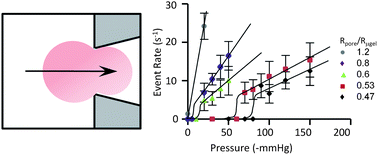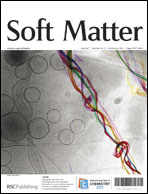Electrical signature of the deformation and dehydration of microgels during translocation through nanopores
Abstract
The resistive-pulse sensing technique was used to investigate the deformation and dehydration of individual 570 nm radius poly(N-isopropylacrylamide-co-acrylic acid) microgels during their translocation through a glass membrane containing a single conical nanopore with orfice radii ranging from 200 to 700 nm. Microgel translocation rates were found to be dependent on both the applied pressure and the pore radius, and a translocation threshold pressure was found to be a function of the pore size. Importantly, current–time traces resulting from translocation events demonstrate changes in the conductivity of the microgel, due to compression and partial dehydration during translocation. A minimum nanopore-to-microgel radius ratio of ∼0.4 is observed for translocation, suggesting a theoretical limit imposed by the compressibility of the microgel and Columbic repulsion with the pore walls. Our results provide fundamental insight into microgels including their compressibility and conductivity, as well as the ability of soft particles to permeate porous membranes and pass through voids of dimensions smaller than the particles themselves.


 Please wait while we load your content...
Please wait while we load your content...